Performance Marketing vs Digital Marketing: Which One is Better?
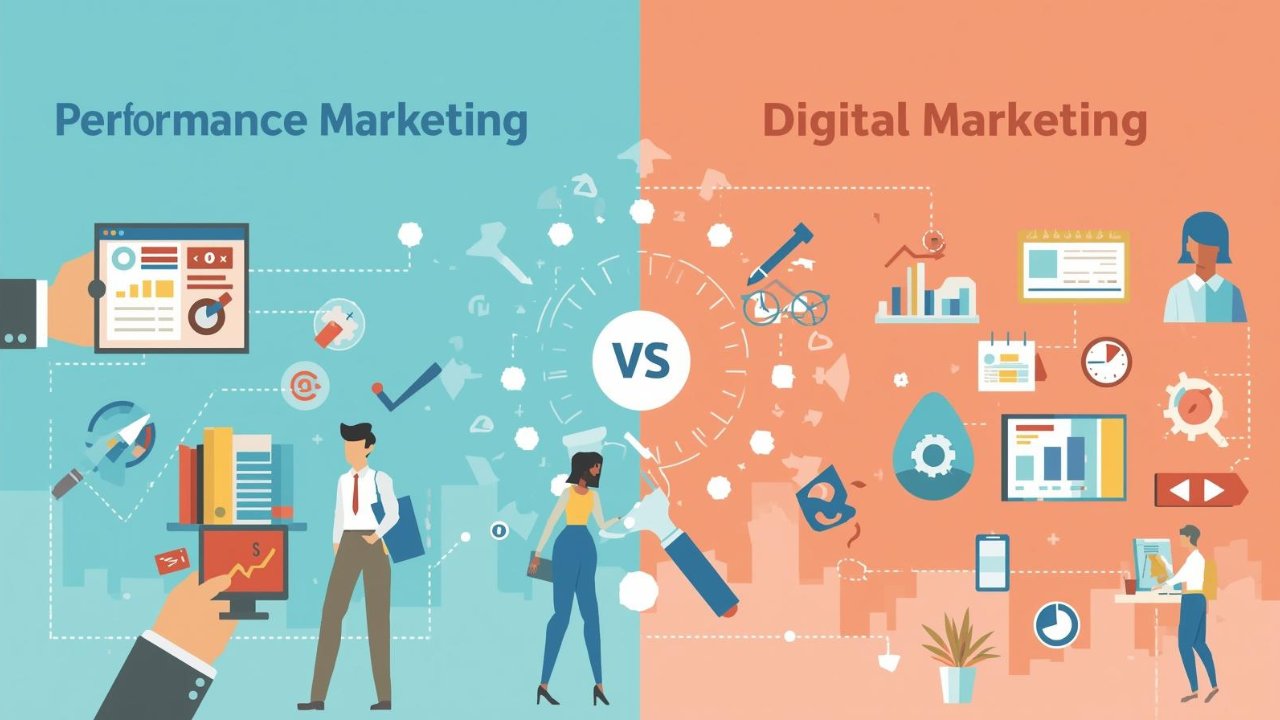
As businesses move through today’s competitive digital landscape, there is one box that must be checked: performance marketing vs digital marketing. Follow this comprehensive guide so you can identify the differentiators, benefits, and strategies of both digital marketing strategies, thus easily continuing to scale your business into 2025.
Performance Marketing vs Digital Marketing: The Core Difference
The key differences between the advantages of performance marketing and digital marketing are in how they acquire customers and drive brand growth. Performance marketing is a results-focused, highly discipline of digital marketing, that is concerned only with measurable metrics and conversions. Digital marketing is a comprehensive ecosystem of online marketing activities to promote a brand, engage customers, and develop meaningful engagement and relationship with a digital marketing consultant. When comparing performance marketing vs digital marketing, the main factor is that performance marketing focuses on measurable actions like clicks and sales.
Performance marketing operates under a pay-for-performance model, where advertisers only pay for performance when certain actions occur such as a click, a lead, or sale, or some pre-determined goal. Due to the tight focus on short-term, measurable results that can be tracked and particularly optimized in real-time, it is able to successfully nurture interest and hunger for performance. Digital marketing rolls up all elements of a customer’s brand experience that includes brand building, educating customers, engaging with communities, and developing relationships that may not drive short-term returns, but do ultimately enhance competitive advantages over time performance marketing consultant.
What is Digital Marketing?
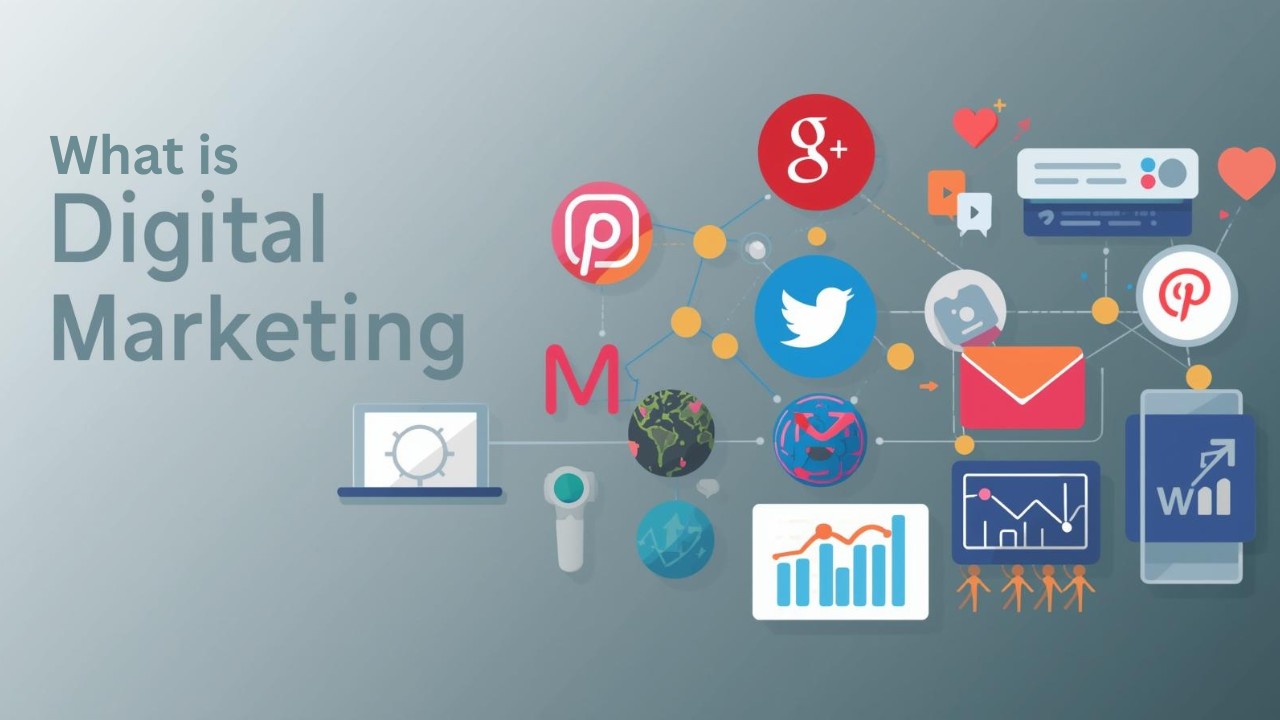
Digital marketing is any form of marketing efforts that use electronic devices and the internet to connect with customers. It is the general term for every instance an online touchpoint happens between your business and potential customers online, to raise awareness, generate interest, build rapport, and grow your business. Understanding performance marketing vs digital marketing helps businesses choose the right strategy for their goals and budget.
Key Components of Digital Marketing:
- Content marketing: Develop blog posts, info & promo videos, podcasts, and other contents.
- Search Engine Optimization(SEO): Showing your website top in search results for organic visibility.
- Social Media Marketing: Creating contents for branding and engaging with an audience.
- Email Marketing: Communicating directly with prospects and also nurturing leads through campaigns.
- Brand Building: Strategies and activities that build trust and familiarity.
- Public Relations: Thought leadership campaigns and media attention
- Influencer Partnerships: Influencer by partnering with industry leaders.
The primary goals of digital marketing extend beyond immediate sales to include lead generation, brand awareness, customer education, relationship building, and market positioning. It’s a long-term strategy that creates owned assets – your website traffic, email subscribers, social media followers, and brand recognition – that continue generating value over time. The topic performance marketing vs digital marketing is important for companies that want to balance long-term branding with short-term results.
What is Performance Marketing?
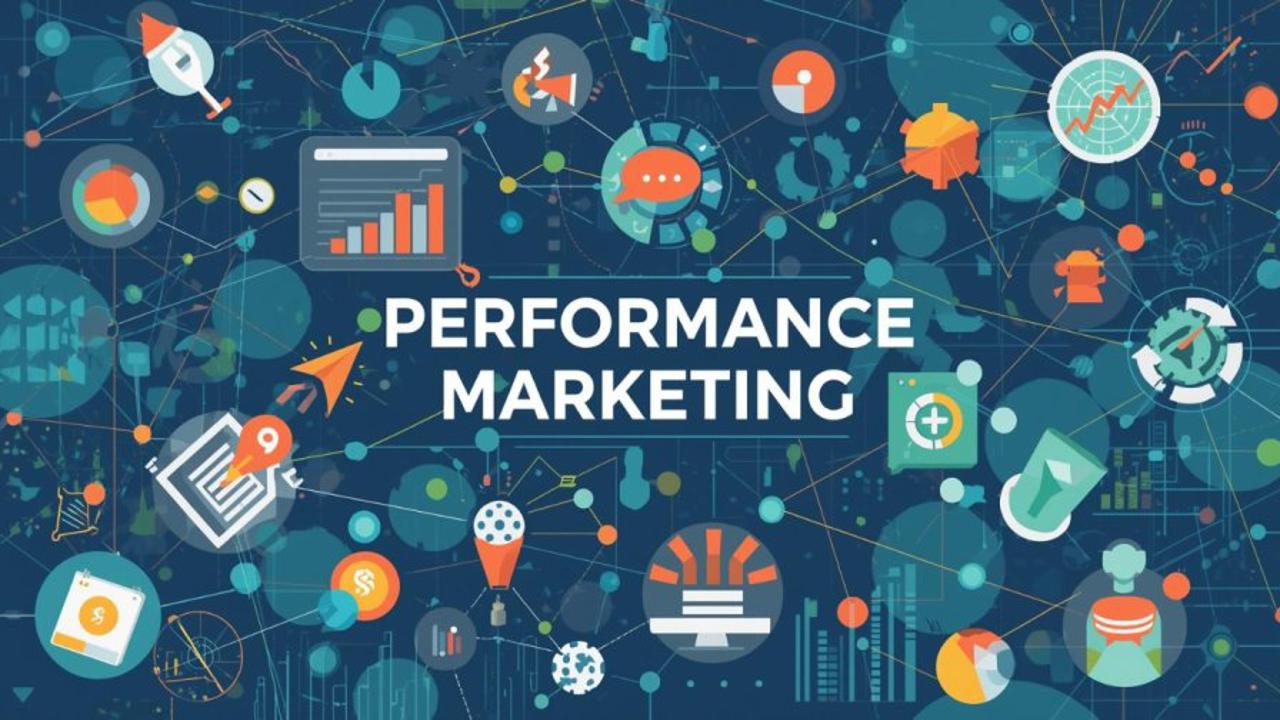
Performance marketing is a specialized approach within digital marketing where advertisers pay marketing companies or advertising platforms based on specific performance metrics. It’s outcome-focused marketing that ties every dollar spent directly to measurable results like clicks, leads, or sales.
Core Performance Marketing Channels:
- Paid Search Ads: Google Ads or such type ads targeting keywords with high intent
- Social Media Ads: Facebook, Instagram, or LinkedIn ads for conversion
- Display Ads: Banner ads that include retargeting
- Native Ads: Content that appears in an editorial format
- Affiliate Marketing: Partners promoting your products for a commission
- Influencer Partnership: Measurement of performance including potential collaborations
Many marketers explain performance marketing vs digital marketing by comparing ROI-focused campaigns with overall digital presence. Each program must prove its return on investment through metrics that track cost per acquisition, return on ad spend, conversion rates, etc. For an advertiser to incur a fee, a specified action must be completed, which lowers the risk for businesses that require more predictable outcomes.
Key Differences Between Performance Marketing and Digital Marketing
Timeline and Results Expectations on Performance marketing vs Digital marketing
Performance Marketing- has very short timelines. To put it simply, you can launch a campaign on Monday morning and have results before Friday afternoon. That’s one of the reasons Performance Marketing is so effective for companies that need immediate revenues, have limited-time seasonal offers, and want to confirm product-market fit quickly. Unfortunately, the results stop as soon as the spending stops.
Digital Marketing- requires patience and a long-term viewpoint. Content marketing can take a minimum of 3-6 months to deliver meaningful results. Rankings from new SEO improvements are typically not impactful until they have been generating links and traffic (6-12 months). Brand awareness campaigns usually take 12-18 months for measurable market recognition.
Payment Models and Risk Distribution
Performance Marketing- allows advertisers to distribute risk through pay-for-performance models. You are paying for clicks, leads, or sales, which makes budget planning more certain and return on investment calculations predictable.
Digital Marketing- is often about paying for potential and not guaranteed success. You are paying for content creation, SEO services, social media management of your brand, or brand building activities that may not result in an immediate conversion but creates valuable assets for the long run.
Measurement and Attribution- Performance marketing vs Digital marketing
Performance Marketing excels in clear, immediate measurement. Attribution is typically straightforward – someone clicks an ad and makes a purchase. Metrics provide instant feedback for optimization decisions.
Digital Marketing measurement is more complex and requires patience. A customer might discover your brand through organic content, engage on social media, subscribe to your email list, and purchase months later through a retargeting ad.
Metrics to Measure Performance Marketing
Primary Performance Marketing KPIs:
Cost Per Mille (CPM): Indicates cost incurred per 1,000 impressions—not necessarily views—of your ad to potentially engaged customers. Even though impressions do not guarantee engagement, they will give values to campaigns focused on brand awareness, and are useful when comparing to cross-channel efficiencies.
Cost Per Click (CPC): It is the cost used every time someone clicks on your ad. This is a useful metric to evaluate targeting strategy and ad copy and creative efficiencies.
Cost Per Acquisition (CPA): indicates the overall cost to acquire one new customer. The metric takes total marketing cost, then divides it by the total number of new customers acquired. This metric directly impacts carefully tracking profitability calculations.
Return on Ad Spend (ROAS): computes revenue on every dollar of ad spend. A 4:1 ROAS would indicate every dollar spent on advertising generates four dollars in revenue.
Conversion Rate: The percentage of website visitors or ad clicks that completed the desired action— purchase, sign up, download, or other goal.
Lifetime Value to Customer Acquisition Cost Ratio (LTV:CAC): LTV compares the total value of a business relationship with a customer throughout their relationship with your business, to what it cost to acquire them.
Types of Performance Marketing
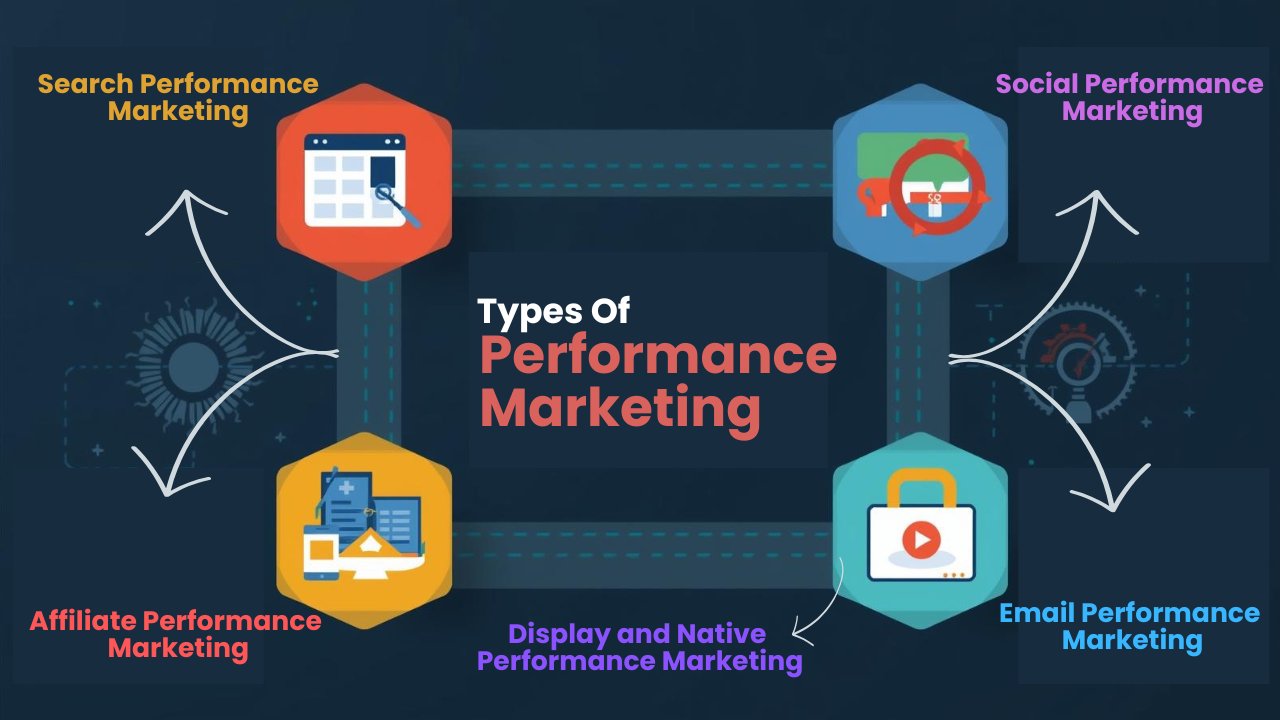
1. Search Performance Marketing
Search performance marketing is where you pay for ads that appear when someone searches for certain keywords on a search engine. Performance marketing using search will typically convert some of the highest-intent prospects looking for solutions, because you have paid to bid on the relevant keywords within a bid system.
2. Social Performance Marketing
Social performance marketing drives the paid advertisements on social platforms including Facebook, Instagram, LinkedIn, Twitter/X, and TikTok. Based on demographics, interests, behaviors, and connections, you can advertise and reach similar or exact audiences. These social platforms offer unique experiences that translate very well into visual storytelling while providing significant granularity about who to reach with your advertising campaigns.
3. Email Performance Marketing
Email performance marketing involves targeted campaigns with email that compel recipients to perform certain actions – purchase, sign-up, download, or register. Examples of performance marketing through email are abandoned cart sequences, product launch campaigns, and emails triggered by certain behaviors.
4. Display and Native Performance Marketing
Display performance marketing refers to banner ads, video ads, and native advertising that appears on popular websites and apps. In native advertising, the ad matches the look and format of the editorial content so that it is less disruptive, while still recording and tracking the same performance metrics as any other performance marketing.
5. Affiliate Performance Marketing
Affiliate performance marketing involves other companies or individuals who actively promote your products in return for commissions based on demonstrated results, encompassing influencer partnerships and referrals.
Types of Digital Marketing
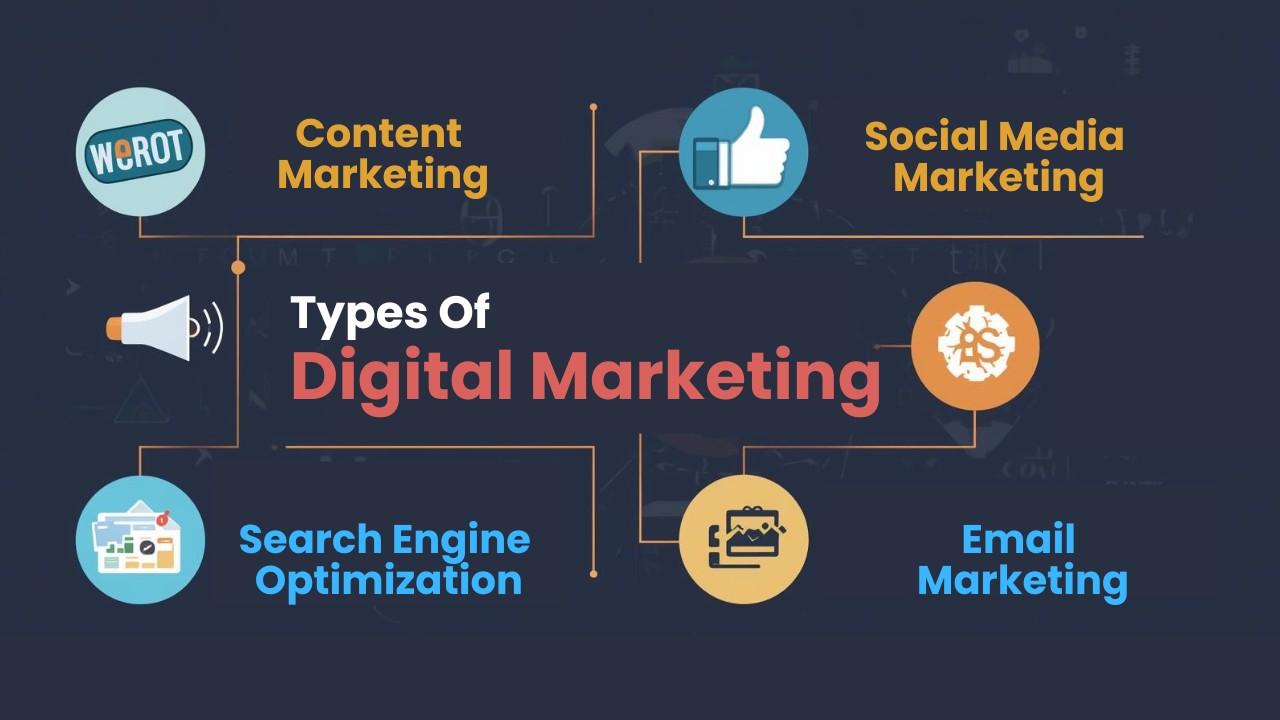
1. Content Marketing
Content marketing entails creating and distributing content to add value and relevance as a means to attract, engage, and retain a defined audience. Content marketing can assume multiple forms, including long-form posts, developer video series, podcasts, downloadable files, and Case Studies.
2. Search Engine Optimization
Search Engine Optimization consists of optimizing your website/content so that you rank in organic search engine results for relevant keywords. The key difference between SEO and paid search ads is that, with SEO, you may rank and be visible for extended periods of time without a continual paid advertising expense.
3. Social Media Marketing
Social media marketing includes actively building communities and conversations on the platforms used by your target audiences outlined, and the how will look very different depending on the platform-Lincoln’s emphasis will be about the B2B connection to launch their network; Instagram about the story-you would have to engage to connect; Twitter about real-time conversation.
4. Email Marketing
Email marketing is about nurturing a direct engagement with individuals that had agreed to receive your content on a regular basis. Advantages of Email marketing could take the form of welcome series, newsletters, email courses, customer case stories, or similar content offers. Brand Building Company Brand building is the awareness, trust, and positive association of your business name and reputation in the market. To build a brand you could use activities like thought leadership in your field of expertise, media coverage, community.
Budget Allocation Strategies
1. Startup Phase (0-2 Years)
Recommended allocation: 70% Performance Marketing, 30% Digital Marketing
Startups often require immediate revenue validation and cash flow. Performance marketing vs Digital marketing allows for quick feedback in terms of product-market fit while a digital marketing investment should address foundational factors building from something like basic website optimization, email marketing or an initial SEO setup to ensure it provides the minimal viable brand promises on which start up performance marketing ultimately shines.
2. Growth Phase (2-5 Years)
Recommended allocation: 50% Performance Marketing, 50% Digital Marketing
Similarly, growth stage businesses have validated a business model and replicate and scale but they need a sustainable competitive advantage to grow as well as scale efficiently Performance marketing vs Digital marketing. Finding balance with sustainable growth opportunities allows growth stage businesses to not only continue to maximize growth but also implement pertinent foundations of line of business.
3. Mature Phase (5+ Years)
Recommended allocation: 30% Performance Marketing, 70% Digital Marketing
Mature businesses need to understand how to manage their digital marketing investment style(s), building brand equity and thought leadership, while using performance marketing vs Digital marketing investment style(s) to take advantage of immediate opportunity, as well as a test market new product.
Common Mistakes to Avoid
1. Applying Success Metrics Incorrectly
The most frequent mistake is viewing a Performance marketing vs digital marketing initiative with performance marketing metrics, or vice versa. The expectation that content marketing and brand building can yield value right away sets unrealistic expectations on what digital marketing achieves and causes brands to make premature cuts to their budget and resources.
2. Being Too Reliant on Performance Marketing
Many organizations might find themselves addicted to immediate gratification of performance marketing via sales, losing sight of the value of building long-term assets. Organizations that rely too heavily on performance marketing vs Digital marketing expose themselves to risks of the changing landscape of performance platforms, algorithms and ever-increasing costs of advertising.
3. Digital Marketing Without A Path to Conversion
Some organizations that build-out their content and social media programming do so without any paths to revenue – businesses often find they can reach high levels of engagement but no meaningful revenue. Performance marketing vs Digital marketing must include clear paths to conversion for customers through their journey.
4. Team Silos and Competition
Internal groups within organizations will typically vie for budget and credit rather than collaborate on similar objectives with measurable outcomes. The internal competition leads to minimal impacts from either effort, as well as lost opportunities of Performance marketing vs Digital marketing.
Future Trends
Privacy-First Marketing Change- Performance marketing vs Digital marketing
Internal groups within organizations will typically vie for budget and credit rather than collaborate on similar objectives with measurable outcomes Performance marketing vs Digital marketing. The internal competition leads to minimal impacts from either effort, as well as lost opportunities.
Integration of AI- Performance marketing vs Digital marketing
Future of AI technology development is improving both marketing performance-based capabilities, from automated bidding and dynamic creative testing, while improving digital marketing’s capabilities through content personalization and predictive analytics.
Growth of Community-Based Marketing
Modern consumers desire authentic communities and relationships with brands, rather than a traditional advertising messages or impressions or clicks. This is beneficial to digital marketers by developing community channels and user-generated content programs.
Evolving Behaviors for Voice and Visual Searches- Performance marketing vs Digital marketing
The behaviors around search are evolving towards voice-query and visual search behaviors which both create opportunities for both marketing performance and digital marketing for different reasons. Digital marketing can create long-form content for voice search and performance marketing continues to work on identifying conversational keywords to develop content around.
Conclusion- Performance marketing vs Digital marketing
The selection regarding performance marketing vs digital marketing is not either or. Successful businesses leverage both options, which is the correct strategy. Performance marketing establishes immediate outcomes and clear ROI for quick revenue validation while digital marketing builds competitive advantage by building brand equity and customer relationships over time.
The relative emphasis of either option depends on the life stage of your business, industry, and growth objectives – for instance, start-ups that are focused on validating revenue tend to adopt performance marketing, whereas established businesses would favour investing more in building their brand in the long term. To really create value, avoid common pitfalls such as scenario planning via team siloing, wrong metrics, or trading time if you are over-weighting one of the 2 approaches over the other. Ultimately, the most successful marketers do not choose performance marketing vs digital marketing options as they integrated both options as part of a unified plan to create immediate outcomes that provide the benefits of building sustainable competitive advantage over time.
Frequently Asked Questions (FAQ)
1. What's the main difference between performance marketing and digital marketing?
Performance marketing is a results-focused subset of digital marketing where you only pay when specific actions occur (clicks, leads, sales). Digital marketing is the broader ecosystem that includes brand building, content creation, SEO, and relationship development. Performance marketing delivers immediate, measurable results, while digital marketing builds long-term brand equity and customer relationships.
2. Can I succeed with just performance marketing?
While performance marketing can deliver immediate results, relying solely on it creates significant risks. You become vulnerable to platform changes, algorithm updates, and increasing advertising costs. Without digital marketing’s brand-building foundation, you’ll struggle to create sustainable competitive advantages and owned assets that provide long-term value.
3. How long does it take to see results from each approach?
Performance marketing can show results within days or weeks—you can launch a campaign Monday and see outcomes by Friday. Digital marketing requires patience: content marketing takes 3-6 months for meaningful results, SEO improvements need 6-12 months to show impact, and brand awareness campaigns typically require 12-18 months for measurable market recognition.
4. Which metrics should I focus on for each approach?
For performance marketing, focus on: Cost Per Acquisition (CPA), Return on Ad Spend (ROAS), conversion rates, and Cost Per Click (CPC). For digital marketing, track: organic website traffic, engagement rates, email open/click rates, brand awareness surveys, average session duration, and lifetime customer value. Don’t apply performance marketing metrics to brand-building activities or expect immediate ROI from long-term digital marketing efforts.
5. Is performance marketing more expensive than digital marketing?
The cost structure is different, not necessarily higher. Performance marketing uses pay-for-results models, making costs predictable and directly tied to outcomes. Digital marketing often requires upfront investments in content creation, SEO, and brand building without guaranteed immediate returns. However, digital marketing creates owned assets (website traffic, email lists, brand recognition) that provide ongoing value, while performance marketing results stop when spending stops.
